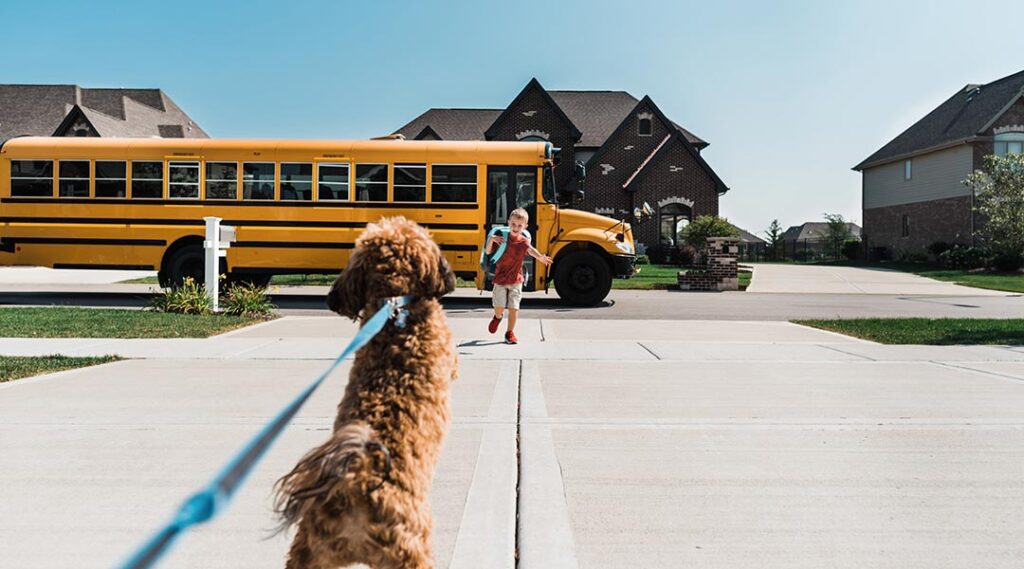This post was originally published on www.progressive.com
In every state, you must stop for a school bus if you’re traveling behind the bus and it comes to a stop, regardless of whether it has any flashing lights. School bus laws by state vary in terms of how far away from a school bus you must stop, situations where you’re traveling in the opposite direction, or if the bus driver has stopped in a loading zone.
Why is stopping for a school bus important?
According to the American School Bus Council, children are about 70 times more likely to get to school safely if they take the school bus instead of going in a regular passenger vehicle. The most dangerous points of the journey are when children get on and off the bus, potentially crossing a road in the process. Stopping for a school bus helps ensure that children can cross the road safely.
When do you have to stop for a school bus?
Driving on the same side of the road
All states have very straightforward laws for stopping for a school bus when you’re following the bus. There’s only one exception to these rules when you’re on the same side of the street as the bus. If the bus has pulled into a loading zone, and there’s no walkway for pedestrians that connects the loading zone with the road on which you’re driving, then you don’t have to stop.
- When yellow lights start flashing, slow down. Don’t try to pass the bus before it stops. Some states require you to go down to a specific speed limit when the yellow lights flash. All states want you to slow down and prepare to stop.
- When the red lights flash, stop. Some states require you to stop at specific distances from the bus. The minimum may be anywhere from 20 to 100 feet.
- When the lights stop flashing, proceed with caution. You can start driving again but be especially alert for children running to and from the bus stop as you pass it.
Driving on the opposite side of the road
Most states apply the same laws about slowing down and stopping for a school bus even if you’re traveling in the opposite direction of the bus. A few states offer exceptions in certain circumstances. Check with your state’s Department of Motor Vehicles (DMV) to determine whether any of these exceptions apply where you live.
A divided highway has a physical median or barrier separating traffic moving in opposite directions. Some states say you don’t have to stop for a school bus on a divided highway if you’re on the opposite side of the road. The laws vary by the type and width of the median or barrier.
Some states consider the total number of lanes. You may not have to stop if you’re on the opposite side of the road and there are a least a certain number of total lanes (e.g., two lanes in each direction totaling four lanes). Turn lanes may be counted also.
Always be alert when passing a school bus in the opposite direction. Children sometimes do unexpected things, and they don’t always cross the road by using authorized walkways.
Can you pass a school bus if the stop sign is not out?
In addition to flashing lights, most school buses have a “stop arm” sign that extends outward when the bus comes to a stop. However, it doesn’t matter if the bus doesn’t have the stop arm, or if it doesn’t deploy. If the bus comes to a stop, you need to obey all the laws in your state about stopping for school buses.
What are the penalties for not stopping for a school bus?
School bus laws are some of the strictest driving laws on the books. The penalties for not stopping can include any of the following:
- Tickets and fines
- Driving safety classes
- Community service time
- Points on your driving record
- Higher car insurance rates
- Suspension or loss of your driver’s license
- Misdemeanor or felony charges (which may also include jail or prison time)
More tips for driving safely near school buses
Obeying traffic laws is the first step in keeping kids safe around school buses. Your heightened awareness while driving in certain situations can help too.
- School bus schedules: Be especially alert when school buses are operating — usually between 7-9 a.m. and 2-5 p.m.
- When you are leaving your home: Be careful when pulling out of your garage or driveway, and watch for kids passing by.
- When you are driving in neighborhoods and school zones: Drive slowly in these areas, especially on streets with no sidewalks.
- Kids are often in a hurry: If kids are worried about being late for a bus or excited to be off the bus and headed home, they may not be paying attention to cars on the road.
No one wants to hurt a child or put one at risk. It’s up to all drivers to be patient and careful around school buses to help keep kids in our communities safe.
[ad_1]
